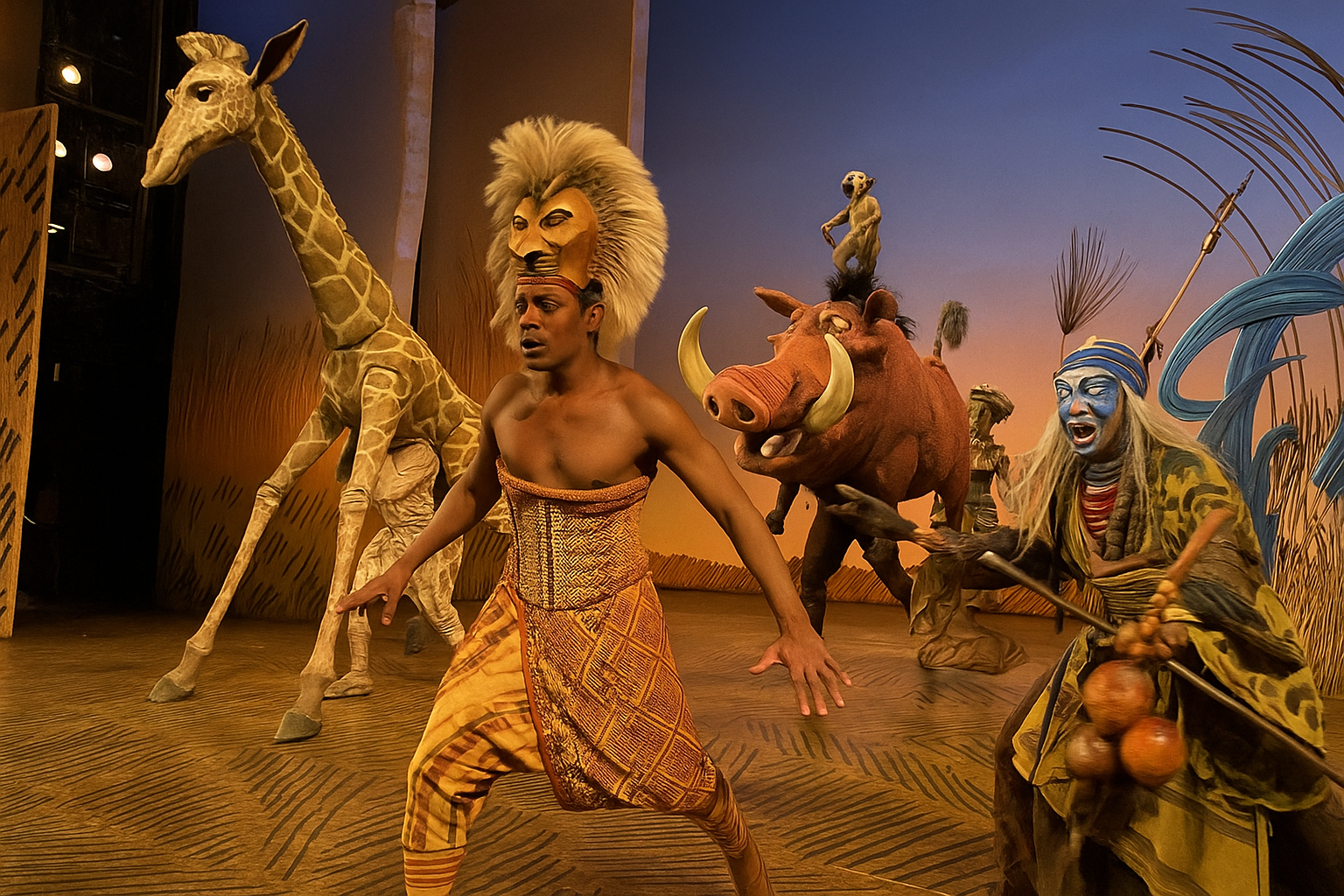Musical Spotlight: The Lion King
By Broadwaytrax Content Studio · October 22, 2025
Updated October 22, 2025
The lights fade. A powerful voice calls out: Nants’ Ingonyama. As the sun rises, animals parade through the aisles. Within moments, The Lion King draws you into its magic. Julie Taymor’s vision shows both the animals and their human counterparts. This blend, known as the “double event,” transformed how stories are told on Broadway (Smithsonian Magazine).
Why does this show still matter? It runs nearly every night at the Minskoff Theatre. Families come back to see it again and again, sharing the experience with new generations. Artists study its design and sound (Broadway.org — The Lion King (Minskoff Theatre)). A decade ago, it became the highest-grossing entertainment title ever (BBC News). On Broadway, it marked its 10,000th performance in 2023 (Playbill). Meanwhile, the West End celebrated 25 years in 2024 (Disney Tickets UK). Unlike our recent articles focused on themes like politics or friendship, this one dives into the artistry of sound and movement.
Bring "The Lion King" to life with custom tracks
Get the exact arrangement you need—either customize an existing accompaniment or commission a bespoke build from our team.
The story centers on Simba, a lion cub destined to be king. After a family tragedy, he flees and forgets his past. Friends and memories help him return home, where he learns that being a leader means helping others, not just being strong. The stage version enhances characters like Nala, Rafiki, and Mufasa with new songs like Shadowland and He Lives in You. These songs give deeper meaning to themes of pride, loss, and hope (The Lion King — Official Site (US)); (Smithsonian Magazine).
The creative team created a unique show. The book was written by Roger Allers and Irene Mecchi. Elton John composed the music, and Tim Rice wrote the lyrics. Lebo M, Mark Mancina, Jay Rifkin, Julie Taymor, and Hans Zimmer contributed additional music that highlights African choral influences. Julie Taymor directed, while Garth Fagan choreographed the dynamic movements. Richard Hudson designed the stunning savanna setting. Taymor and Michael Curry created the masks and puppets, bringing the characters to life. Donald Holder’s lighting filled the stage with color. Robert Elhai arranged the orchestral music, with help from David Metzger and Bruce Fowler (The Lion King — Official Site (US)).
The journey to Broadway started with a tryout in Minneapolis in 1997. The show opened at the New Amsterdam Theatre later that year and moved to the Minskoff Theatre in 2006, where it still performs today (Playbill Vault: The Lion King (1997 Broadway)); (Broadway.org — The Lion King (Minskoff Theatre)). In London, it has played since 1999 and is now a West End landmark (Disney Tickets UK).
The show features signature songs that fans love. Circle of Life stirs the audience with powerful choral music. Hakuna Matata brings laughter, and Can You Feel the Love Tonight adds sweet romance. Be Prepared creates tension. New songs like They Live in You/He Lives in You, Endless Night, and Shadowland deepen the story’s roots (The Lion King — Official Site (US)). The music blends English with African languages such as Zulu and Xhosa, making the experience truly unique (Smithsonian Magazine); (The Lion King London — About the Show).

The staging is truly groundbreaking. Giraffes walk on stilts. A dancer holds a painted frame to mimic a cheetah. Birds soar on bamboo rigs. The effect showcases both the mechanics and the magic, enhancing the audience’s connection to the story (Smithsonian Magazine). The production uses hundreds of costumes and over 200 masks and puppets to represent over 25 animal types, turning the stage into a beautiful painting in motion (The Lion King London — About the Show). This stunning design elevated what storytelling can look like on stage (The Lion King — Official Site (US)).
The show earned six Tony Awards soon after opening, including Best Musical and Best Direction for Julie Taymor, the first woman to win this honor for a musical. It also received a Grammy for Best Musical Show Album (Tony Awards — The Lion King). Over the years, it has set records for attendance and income (BBC News); (Disney On Broadway); (Playbill).
The cultural impact is significant. The show introduced African musical styles and languages to mainstream audiences. It made puppetry exciting and visible. It opened doors for many designers and performers who use movement and storytelling (Smithsonian Magazine); (Disney On Broadway).
Performers benefit from learning the score, which emphasizes rhythm and open vowels. Audition selections often include songs like Shadowland, Endless Night, and He Lives in You. Understanding the musical rhythm and practicing choral harmonies is crucial (The Lion King — Official Site (US)); (Smithsonian Magazine).
Sing The Lion King with full orchestra.
Download the AlbumFor educators and producers, the show serves as a model for using movement in storytelling. Engage students in mask and puppet work early on. Even smaller spaces can replicate the show’s surround-sound effect. Incorporate language coaching to improve diction and make performances feel genuine (The Lion King London — About the Show); (Broadway.org — The Lion King (Minskoff Theatre)); (Playbill Vault: The Lion King (1997 Broadway)).
Whether you’re an audience member, a student, or an educator, The Lion King shows how a familiar story can feel fresh through the magic of sound, image, and creativity.
You see the animal and the human at once.
Choose cuts like Shadowland, Endless Night, or He Lives in You. Work groove, blend, and clear Zulu/Swahili diction before adding power.
Schedule movement and mask/puppet training early. Place visible percussion to echo the show’s surround feel, even in small venues.